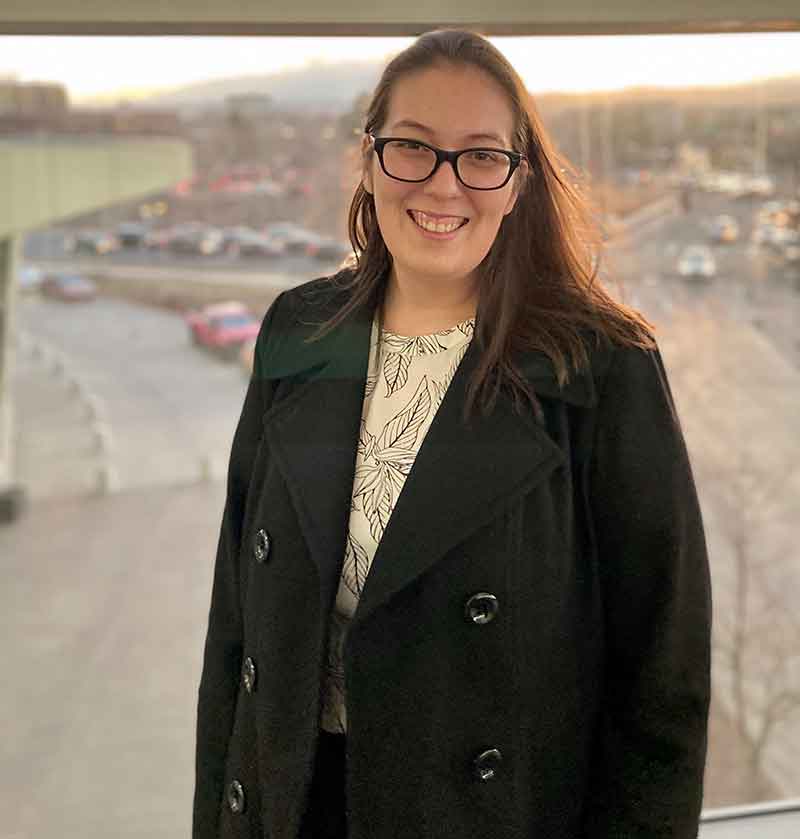Meet a Participant: Julia Ream

Julia Ream spent the summer of 2020 contributing research to help reduce the cost of chemical kinetics in combustion simulations as a participant in the National Science Foundation’s Mathematical Sciences Graduate Internship Program. (Photo credit: Alex White/Florida State University)
Mathematician explores ways to reduce costs of combustion simulation research
In order to better understand combustion, scientists often employ computer simulation technology to fine tune its chemical processes and better understand its mechanics. The combustion process can take time, which increases the cost of the research.
During the summer of 2020, Julia Ream, doctoral candidate at Florida State University (FSU), spent 10 weeks coding and analyzing combustion simulations to reduce the cost of chemical kinetics in the National Science Foundation’s (NSF) Mathematical Sciences Graduate Internship (MSGI) Program.
The NSF MSGI Program provides research opportunities for mathematical sciences doctoral students; allowing them to participate in internships at national laboratories, industries and other facilities. These opportunities provide hands-on experience using mathematics in a nonacademic setting.
Alongside the combustion team in the Center for Computational Sciences and Engineering (CCSE) at Lawrence Berkeley National Laboratory (LBNL), and under the mentorship of Anne Felden, postdoctoral researcher, and Marc Day, senior scientist, Ream sought to simplify some of the algebraic expressions used in the chemistry portion of the simulations by using quasi steady state assumptions (QSSA).
In chemical kinetics research, QSSA is a well-known model reduction method used to relieve some of the computational cost associated with highly reactive intermediate reactant species that often stiffen the problem. While such species remain important, they do not need to be resolved with high accuracy.
“Computing the chemistry in reacting flow simulations can take up to 90% of the simulation cost,” said Ream. “However, using QSSA allows for certain reactant species within the simulation to be implicitly represented through their algebraic relationships to other species. Because these implicit species don’t need to be explicitly transported, a reduction in the cost of the chemistry aspect of the simulation is obtained and this saves valuable computing resources.”
Including additional chemistry information in reacting flow simulations eventually enables scientists and researchers to better design and utilize combustion systems.
“This includes making engines more efficient or exploring various fuels for use among the number of different fuel blends on the market,” she said. “In the grand scheme of things, it allows for better development of future technologies.”
For her MSGI research project, Ream edited code that read the chemistry information to account for pre-determined QSSA. The modified code was then able to interpret this information and rearrange the chemistry relations to output a C++ script, or general-purpose programming language, that contains the necessary, reduced chemistry portion to be used by more complex codes during a reacting flow simulation.
“The chemistry model we were specifically looking at during my internship contained 52 transported species,” Ream explained. “Reducing that number by just 10-15 species using QSSA would still allow us to benefit from the additional chemistry information needed to represent these complex fluid systems, while keeping the cost of these combustion simulations manageable.”
Thankful for the opportunity to participate in the NSF MSGI program, Ream felt fortunate about having the chance to learn about subjects she may not have explored so extensively on her own.
“I learned a lot about chemistry,” she said. “Until doing this internship, I did not know that the chemistry aspect of combustion simulations is typically the most expensive part.”
Ream also gained communication skills collaborating with her mentor and alongside the Combustion Team as well as a deeper understanding of Python, a popular programming language for scientific computing.
During her appointment, Ream presented her research at the Summer Intern Poster Session and attended a parallel computing workshop that LBNL hosted. “LBNL also hosted a summer seminar series that allowed us to see the different research projects from various areas of the lab, so we got to get a nice overview of all the research that Berkeley does and what a professional seminar talk looks like,” she said.
She highly recommended the NSF MSGI program to others, saying, “As a mathematician, it’s invaluable to experience how mathematics works in the variety of settings that national labs provide. This program is a great way to dip your toe into the other potential career paths that are open to us that we might not get to see otherwise.”
The NSF MSGI Program is funded by NSF and administered through the U.S. Department of Energy’s (DOE) Oak Ridge Institute for Science and Education (ORISE). ORISE is managed for DOE by ORAU.


